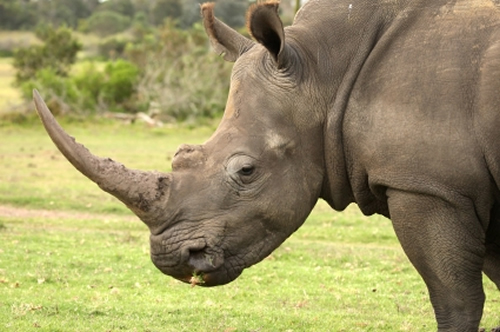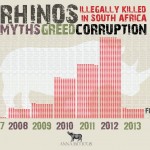
A 2012 economic study concludes that the stockpiling of wildlife products is part of an “extinction strategy” being deployed by rhino horn trade speculators.
The report, published in the Spring 2012 issue of the Oxford Review of Economic Policy, suggests that “current ex situ stockpiles are sufficiently large that profit-maximizing individuals may have an incentive to subsidize the slaughter of rhinos until the wild stock collapses”.
As species become rarer, supplies from the wilds will dwindle and prices go up, which can invite additional pressure on extant populations. In other words, extinction may be an incentive-driven process, via the price mechanism. These forces are exacerbated when a significant market player holds significant stockpiles of wildlife commodities.
Legalizing rhino horn trade for one species, the authors argue, could create opportunities for laundering horns from other rhino species, noting that the extinction strategy is “particularly worrisome in cases where the extinct species is similar to surviving species” (the black and white rhino are used as an example). A version of this scenario is already at play in South Africa, where hundreds of white rhino horns have been laundered for the illegal market by safari operators colluding with “hunters” from Southeast Asia, particularly Vietnam and Thailand.
While the authors consider farmed rhinos as an alternative supply of horn — theoretically reducing pressure on wild rhinos — they also point out that owning a “renewable resource” makes the scarcity (and ultimate extinction) of the species in the wild even more desirable for farmers and speculators.
Bear (or tiger) farming implies that speculators ‘own’ a renewable resource, rather than an exhaustible stockpile of a commodity such as rhino horn or ivory. This implies that they are able to enjoy monopoly rents for a longer, indeed potentially infinite, period, which enhances the profitability of banking on extinction.
Despite the abundance of farmed bear bile in China and other Asian markets, wild bears are still killed for their gallbladders throughout Asia and North America. It is likely that farming rhinos for horns would hasten the demise of wild rhinos, rather than serve as a protective measure.
Three recommendations to reduce the incentives to “bank on extinction” are set forth in the paper. The first is the removal of stockpiles from the private to the public sector, where the stockpiles could be “strategically used to enhance conservation” since private stockpiles are “potentially dangerous liabilities when in the hands of profit-maximizing individuals”. (However, this strategy assumes at a minimum that 1) the public sector is free of corruption; 2) sufficient control mechanisms are in place to prevent laundering of illegally acquired horns with legal sales; and 3) horns would not be re-acquired and accumulated by speculators, thereby defeating the purpose.)
Secondly, the authors explain that the incentive to profit from extinction could be minimized by implementing “information campaigns to reduce demand” and finally, they advise keeping trade sanctions in place — even if a species is lost to extinction.
Source: Charles F. Mason, Erwin H. Bulte, and Richard D. Horan. Banking on extinction: endangered species and speculation Oxf Rev Econ Policy (2012) 28(1): 180-192 doi:10.1093/oxrep/grs006
Image: iStockphoto.com




